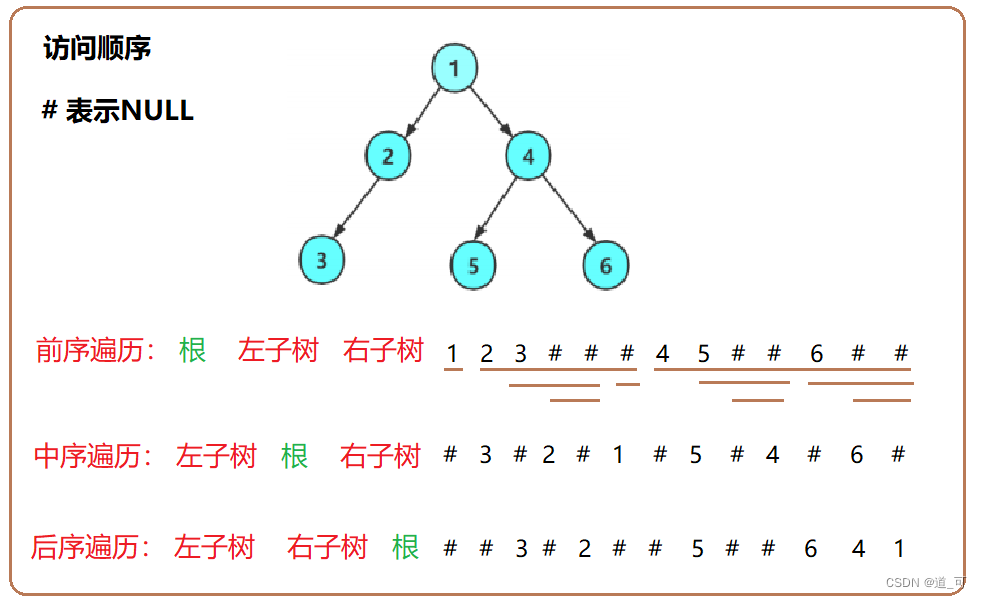前序、中序以及后序遍历
二叉树遍历
(Traversal)
是按照某种特定的规则,依次对二叉
树中的节点进行相应的操作,并且每个节点只操作一次
。
按照规则,二叉树的遍历有:
前序/中序/后序
的递归结构遍历
:
- 1. 前序遍历(Preorder Traversal 亦称先序遍历)——访问根结点的操作发生在遍历其左右子树之前。
- 2. 中序遍历(Inorder Traversal)——访问根结点的操作发生在遍历其左右子树之中(间)。
- 3. 后序遍历(Postorder Traversal)——访问根结点的操作发生在遍历其左右子树之后。
由于被访问的结点必是某子树的根,
所以
N(Node
)、
L(Left subtree
)和
R(Right subtree
)又可解释为
根、根的左子树和根的右子树
。
NLR
、
LNR
和
LRN
分别又称为
先根遍历、中根遍历和后根遍历。
// 二叉树前序遍历
void PreOrder(BTNode* root);
// 二叉树中序遍历
void InOrder(BTNode* root);
// 二叉树后序遍历
void PostOrder(BTNode* root);
前序遍历递归图解
:

//.........................................以上概念性内容均来自比特科技..........................................................
为了更直观的了解,首先手搓一颗二叉树
#include<stdio.h>
#include<assert.h>
#include<stdlib.h>
typedef int BTDataType;
typedef struct BinaryTreeNode
{
struct BinaryTreeNode* left;
struct BinaryTreeNode* right;
BTDataType data;
}BTNode;
BTNode* BuyNode(BTDataType x)
{
BTNode* node = (BTNode*)malloc(sizeof(BTNode));
assert(node);
node->data = x;
node->left = NULL;
node->right = NULL;
return node;
}
BTNode* CreatBinaryTree()
{
BTNode* node1 = BuyNode(1);
BTNode* node2 = BuyNode(2);
BTNode* node3 = BuyNode(3);
BTNode* node4 = BuyNode(4);
BTNode* node5 = BuyNode(5);
BTNode* node6 = BuyNode(6);
node1->left = node2;
node1->right = node4;
node2->left = node3;
node4->left = node5;
node4->right = node6;
return node1;
}其次,我们使用前/中/后序来访问一下:

代码实现:
前序:
//前序
void PreOrder(BTNode* root){
if (root == NULL)
{
printf("# ");
return;
}
printf("%d ", root->data);
PreOrder(root->left);
PreOrder(root->right);
}中序:
//中序
void InOrder(BTNode* root){
if (root == NULL)
{
printf("# ");
return;
}
InOrder(root->left);
printf("%d ", root->data);
InOrder(root->right);
}后序:
//后序
void PostOrder(BTNode* root)
{
if (root == NULL)
{
printf("# ");
return;
}
PostOrder(root->left);
PostOrder(root->right);
printf("%d ", root->data);
}变形
思路:分治算法,分而治之,把大问题转换成类似规模的小问题。(一般采用递归)
1.求二叉树结点的个数
这里有两种方法,①是定义一个全局变量,每递归一次,变量就++一次。
②是先求出左子树结点的个数再加上右子树结点的个数,最后再加上根。因为是递归,所以一直可以向下分割成左右子树,直到遇见NULL树,才不再分割。以下例题,多数都是这种思想。
//求二叉树结点的个数
int count = 0;
int TreeSize1(BTNode* root)
{
if (root == NULL)
{
return;
}
count++;//注:这里需要定义全局变量,因为是递归,所以不能使用局部变量
TreeSize1(root->left);
TreeSize1(root->right);
}
int TreeSize2(BTNode* root)
{
return root == NULL ? 0 :
TreeSize2(root->left) + TreeSize2(root->right) + 1;
//if (root == NULL)
//{
// return 0;
//}
//else
//{
// TreeSize2(root->left) + TreeSize2(root->right) + 1;
//}
}2.求叶子结点的个数
思路:也是两种方法,第一种方法是在上一道例题的基础上,创建一个全局变量,用if判断。
第二种方法就是求出左树和右树的叶子结点然后相加。
//求叶子结点的个数
int TreeLeafSize1(BTNode* root)
{
if (root == NULL)
{
return;
}
if (root->left == NULL && root->right == NULL)
{
count++;//定义一个全局变量
}
TreeLeafSize1(root->left);
TreeLeafSize1(root->right);
}
//方法2
int TreeLeafSize2(BTNode* root)
{
if (root == NULL)
{
return 0;
}
if (root->left == NULL && root->right == NULL)
{
return 1;
}
return TreeLeafSize2(root->left) + TreeLeafSize2(root->right);
}3.求第k层结点的个数
思路:转换成子问题,求左子树的k-1层+右子树的k-1层

//求第k层结点的个数
int TreeKLevel(BTNode* root, int k){
assert(k >= 1);
if (root == NULL)
return 0;
if (k == 1)
return 1;
return TreeKLevel(root->left, k - 1) +
TreeKLevel(root->right, k - 1);
}4.求二叉树的深度
思路:求出左树的深度,再求出右树的深度,加1是加根,然后比较以下,谁大/深返回谁。
//求二叉树的深度
int TreeDepth(BTNode* root)
{
if (root == NULL)
return NULL;
int leftDepth = TreeDepth(root->left)+1;
int rightDepth = TreeDepth(root->right)+1;
return leftDepth > rightDepth ? leftDepth : rightDepth ;
}
5.二叉树中查找值为x结点的值
注:这里值得注意的一点是,返回值的问题以及跳出递归。用前序遍历一下就行。
//二叉树中查找值为x结点的值
BTNode* TreeFind(BTNode* root, BTDataType x)
{
if (root == NULL)
return NULL;
if (root->data == x)
return root;
BTNode* ret1 = TreeFind(root->left, x);
if (ret1) //这里的条件是ret1不为空
return ret1;
BTNode* ret2 = TreeFind(root->right, x);
if (ret2)
return ret2;
return NULL;
}oj练习 - C语言解题
bool isUnivalTree(struct TreeNode* root){
if(root == NULL)
return true;
if(root->left && root->left->val != root->val)
return false;
if(root->right && root->right->val != root->val)
return false;
return isUnivalTree(root->left)&&
isUnivalTree(root->right);
//同时为true 才为true
//一个为false 就返回false
//根 和左孩子右孩子比较,如果不相同,就return false
//如果相同,就继续向下看左子树,再看右子树
//左子树继续向下划分根 左孩子 右孩子
}bool isSameTree(struct TreeNode* p, struct TreeNode* q){
if( p == NULL && q == NULL)//同时为空
return true;
if(p == NULL || q == NULL)//走到这里必定有一个为空,一个不为空
return false;
if(p->val != q->val )
return false;
return isSameTree(p->left,q->left)//左子树跟左子树比较
&& isSameTree(p->right,q->right);//右子树跟右子树比较
}bool isSymmetricSubTree(struct TreeNode* root1,struct TreeNode* root2)
{
if(root1 == NULL && root2 == NULL)
return true;
if(root1 == NULL || root2 == NULL)//走到这里必定一个为空一个不为空
return false;
if(root1->val != root2->val)//必定同时不为空,比较val值
return false;
return isSymmetricSubTree(root1->left,root2->right)
&&isSymmetricSubTree(root1->right,root2->left);
//左树的左孩子比较右树的右孩子
//左树的右孩子比较右树的左孩子
}
bool isSymmetric(struct TreeNode* root){
if(root == NULL)
return true;
//以根为分割线 -- 镜像二叉树
return isSymmetricSubTree(root->left,root->right);
//根的左孩子右孩子传过去
}//注意:返回的值必须要放进malloc申请的数组空间里面
//returnSize :默认不给空间大小,也就是我们需要求出数组的大小
//首先求出malloc数组空间的大小
int TreeSize(struct TreeNode* root)
{
return root == NULL ? 0 : TreeSize(root->left)+TreeSize(root->right)+1;
}
//这里为什么i需要传地址,因为我们需要的是一个i 而不是栈帧空间中的每一个独立的i
//因为下面子树改变i,不会影响上面根的i,这就导致数据可能会重叠,导致后面的空间出现随机数
void prevorder(struct TreeNode* root,int* arr,int* i)
{
if(root == NULL)
return;
arr[(*i)++] = root->val;
prevorder(root->left,arr,i);
prevorder(root->right,arr,i);
}
int* preorderTraversal(struct TreeNode* root, int* returnSize){
*returnSize = TreeSize(root);
int* arr = (int*)malloc(*returnSize * sizeof(int));
int i = 0;//数组下标
prevorder(root,arr,&i);
return arr;
}bool isSameTree(struct TreeNode* p, struct TreeNode* q){
if( p == NULL && q == NULL)//同时为空
return true;
if(p == NULL || q == NULL)//走到这里必定有一个为空,一个不为空
return false;
if(p->val != q->val )
return false;
return isSameTree(p->left,q->left)//左子树跟左子树比较
&& isSameTree(p->right,q->right);//右子树跟右子树比较
}
//思路:把原树中的所有子树都找出来与subRoot进行比较
bool isSubtree(struct TreeNode* root, struct TreeNode* subRoot){
if(root == NULL)
return false;
//遍历所有子树进行比较 ,subroot与root所有的根节点进行比较
if(isSameTree(root,subRoot))
return true;
//角度2.
//先与当前树进行比较,如果不是当前树的子树
//那么就去与当前树的左子树进行比较
//如果也不是
//就与当前树的右子树进行比较
//只要有一个为true 就可以,所有这里是或||
return isSubtree(root->left,subRoot)
|| isSubtree(root->right,subRoot);
}#include<stdio.h>
#include<assert.h>
#include<stdlib.h>
typedef char BTDataType;
typedef struct BinaryTreeNode {
struct BinaryTreeNode* left;
struct BinaryTreeNode* right;
BTDataType data;
} BTNode;
BTNode* BuyNode(BTDataType x) {
BTNode* node = (BTNode*)malloc(sizeof(BTNode));
assert(node);
node->data = x;
node->left = NULL;
node->right = NULL;
return node;
}
BTNode* CreateTree(char* arr,int* i)//前序构建
{
if(arr[*i] == '#')
{
(*i)++;
return NULL;
}
BTNode* root = BuyNode(arr[(*i)++] );
root->left = CreateTree(arr,i);//先构建左子树
root->right = CreateTree(arr,i);//再构建右子树
return root;//返回根节点
}
//中序遍历
void Inorder(BTNode* root)
{
if(root == NULL)
return ;
Inorder(root->left);
printf("%c ",root->data);
Inorder(root->right);
}
int main()
{
char arr[100]={0};
scanf("%s",arr);
int i=0;//数组下标
BTNode* root = CreateTree(arr,&i);
Inorder(root);
return 0;
}
以上仅供参考